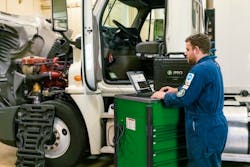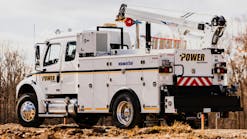Americans have a long-standing tradition of fixing things. For some it’s a source of pride, for others it’s a rite of passage, for still others it is good economics. Fixing is what we do.
Until we can’t. Another American tradition is that if we can’t do what we want, we complain, organize groups, and bring in lawyers. Equipment owners and manufacturers are taking Right to Repair (R2R) issues to center stage this year.
The core issue is equipment owners trying to repair data-driven machines used in agriculture and construction. The golden ticket of telematics has garnered efficiency, yet the closed-loop system that currently controls access to the data needed to repair machines is tarnishing those gains.
Read also: States with active right to repair legislation
Recent changes in OEM optics, proposed state legislation, and legal wrangling in the agricultural equipment industry are catching the attention of construction equipment fleet managers and aftermarket support industries seeking R2R access for their own heavy equipment. The ag trade associations have been making some progress on R2R. Since the major ag equipment OEMs share the same or similar technology and sales/support procedures in the construction equipment they build, it’s reasonable to think that R2R issues and solutions heating up in the ag market will bubble over to construction.
It’s important to note that for this discussion, we are not talking about modifying or enhancing equipment. Chipping (modifying horsepower) and Defeating (disarming emissions) are not repairs. Also of note, Case Construction Equipment, Caterpillar, John Deere, Komatsu, Volvo Construction Equipment, and the Association of Equipment Manufacturers declined requests to be interviewed for this report.
Editor's note: The Associated Equipment Distributors did not respond to initial requests to participate in this article but did respond upon publication. Read it here.
Repair limitations on equipment
Manufacturers say 90 percent of repairs that owners need to do can be done in-house or by an independent repair business. But when a sensor triggers a fault code, the owner’s repair options are limited by the OEM software and other dealer-centric restrictions. Lacking access to the OEM diagnostic tools to interpret the vehicle’s controller network, the owner must hand over control of the analytic procedures, followed by the repair itself, to an OEM dealer or OEM sanctioned repair service. This adds labor costs, down time, replacement components, and inconvenience to the repair. Owners say they are being forced to play by the OEM’s rules.
Manufacturers and their support groups say if the equipment owners had the tools and resources available to dealerships, owners would make illegal modifications to override safety and environmental controls or jack up horsepower. Owners who want to chip or delete are already doing so using parts and instructions available online. John Schmeiser, president of the Canadian branch of the North American Equipment Dealers Association (NAEDA), says members have reported that more than 50 percent of newer farm machines have been illegally modified with a DEF delete kit.
Owners say OEMs who restrict access to their brand’s resources to deter DIY modifications simply add to an owner’s cost of ownership. Owners also point out that manufacturer returns on services and repairs are much more profitable than new equipment sales, which is incentive to keep them in the OEM’s network.
Several manufacturers are seeking to assure customers that they will have access to repair resources by signing memorandums of understanding (MOU) with the American Farm Bureau Federation (AFBF), which speaks for ag equipment owner concerns on R2R.
Deere signed an MOU with AFDF in January, followed in March by Case and New Holland issuing almost identical MOUs.
Editors' note: Kubota, Claas, and AGCO have signed MOUs since this article was published.
Although MOUs are considered legal documents, R2R advocates see no real backbone or enforceable consequences for the OEMs if the manufacturers and their dealers fail to live up to their MOU promises. In return for manufacturer promises, the AFBF has promised not to pursue legislative relief to strengthen R2R practices.
R2RSolution.org is a website created by AEM, NAEDA, and Associated Equipment Distributors (AED) to address the issues. A Statement of Principles, developed by AEM and NAEDA members, calls for achieving “the right balance between giving farmers and ranchers the tools they need while protecting and encouraging innovation.” The groups say R2R legislation is unnecessary and would risk undermining manufacturer software development investments, as well as jeopardize machinery’s compliance with environmental and safety regulations.
Legislative efforts on R2R
On the federal level, the Federal Trade Commission issued a report to Congress called “Nixing the Fix” on how repair restrictions might be anticompetitive in May 2021. The following July, President Biden issued an executive order encouraging the FTC to make rules cracking down on manufacturers that limit users and third-party companies from “barring repairs of their products.”
On March 24, 2023, a coalition of 28 attorneys general signed a letter to the House Energy and Commerce Committee and the Senate Commerce, Science and Transportation Committee expressing support and calling for movement on legislation currently in Congress.
- The Fair Repair Act—introduced in the House in 2021 as HR4006 and in the Senate as S3830 in 2022—would require manufacturers to make certain tools and documents available to independent repair providers and owners.
- The Saving Money on Auto Repair Transportation (SMART) Act, introduced in the Senate as S2801, would allow repair shops to use alternative or off-brand parts to repair vehicles.
- The Right to Equitable and Professional Auto Industry Repair (REPAIR) Act introduced in the House as HR6570, prevents manufacturers from mandating specific brands of parts and equipment be used on a vehicle and would require manufacturers to provide a standardized platform for owners and repair shops to access data and diagnostics.
The above bills are broad in scope, the majority addressing R2R in consumer and auto industries. In 2022, Senator Jon Tester (D-Mont.) introduced a national Agricultural Right to Repair Act, S3549. None has moved beyond the introduction phase.
Since a federal solution is unlikely, R2R advocates are working at state levels to bring awareness and legal solutions to the repair deadlock, a somewhat piecemeal methodology targeting specific industries and the idiosyncrasies of those markets. The idea behind this procedure is if a reasonable law can be passed for consumer segments, eventually the politicians can massage those laws to fit other markets.
See also: States with active right-to-repair legislation
Localizing R2R efforts is gaining support, but results vary by region and markets. Only two states—Texas and Missouri—have a construction equipment R2R bill in their state legislature. Colorado recently passed legislation on agricultural equipment.
Opposition to state legislation is fierce. A report by nonprofit news organization VTDiffer says the Truck and Engine Manufacturers Association, the Outdoor Power Equipment Institute, the Northeast Equipment Dealers Association, the Diesel Technology Forum, and the North American Equipment Dealers Association have all submitted objections to Vermont’s H.81 bill. The article also cited lobbying disclosures filed with the Vermont Secretary of State’s Office that indicate Deere and CNH Industrial have retained the Morris Government Affairs lobbying group. In the Dakotas and Minnesota, R2R legislation is being fought by the Pioneer Equipment Dealers Association.
Equipment manufactures and their support associations maintain that Right to Repair legislation could give owners and independent repair shops access to the vehicle’s embedded code, thus risking safety, durability, and emissions systems. OEMs feel their privately researched and developed intellectual property should be off limits and guarded.
Source code is human readable text such as C or JavaScript primarily used as input to the process that produces an executable program. Source code is assembled into embedded code software. When the source code is compiled into embedded code, the procedure translates the human-legible coding language into a computer-only binary code of 1s and 0s. The embedded binary code must be read by application software that is programmed into the machine’s ECU. Embedded software code has fixed hardware requirements, meaning embedded code is made for a specific machine and will not work with the wrong hardware format. Reverse engineering the embedded code back into the original source code is essentially impossible and is controlled by patents, licenses, and trade secrets.
“Claiming intellectual property is a little hazy,” says Gay Gordon-Byrne, executive director of the Repair Association. According to Gordon-Byrne, Deere uses Linux open-source software in their systems.
“Under U.S. copyright, you’re allowed to do whatever you want with the software on your tractor,” she says. “It’s legal. You can’t turn around and sell it, but you can do whatever you want with it. You can repair it.
“It is totally legal for you to back up everything licensed on your computer for purposes of repair and reload it (including computers in owned equipment),” she says. Citing the 1998 Digital Millennium Copyright Act (DMCA), “The United States Copyright Office granted a very broad exemption to tinkering with software in 2015 for all land-based motor vehicles.”
In its report, “Nixing the Fix,” the FTC concluded that manufacturers have “scant” evidence that limitations on repair are of any benefit to consumers.
The Repair Association offers a model legislative template that addresses access to products with embedded code required for diagnosis, maintenance, or repair. The model template does not mention source code, rather calls for manufacturers to make available embedded software “for purposes of diagnosis, maintenance, or repair, to any independent repair provider, or to the owner of digital electronic equipment manufactured by or on behalf of, or sold by, the original equipment manufacturer.”
The R2R template bill requires manufacturers to make available any special documentation, tools, and parts needed to reset an electronic security lock or function when disabled during diagnosis, maintenance, or repair of the equipment. This software “key” allows access to the vehicle’s embedded code so owners could diagnose and fix a problem, but they could not modify environmental or safety systems. Because the embedded code cannot be back-translated into the original source code, R2R advocates say that OEM concerns that competitors will steal their proprietary intellectual property are diminished.







